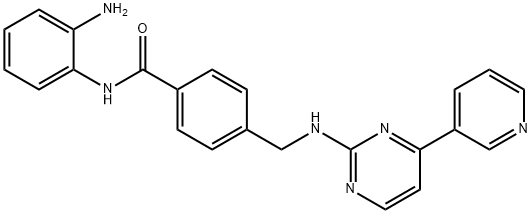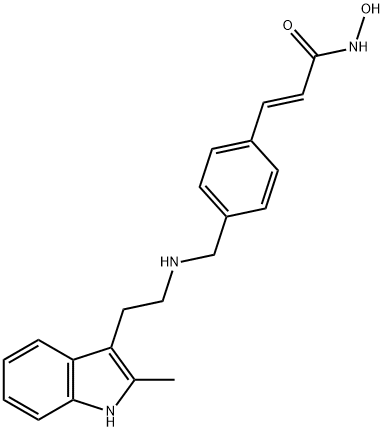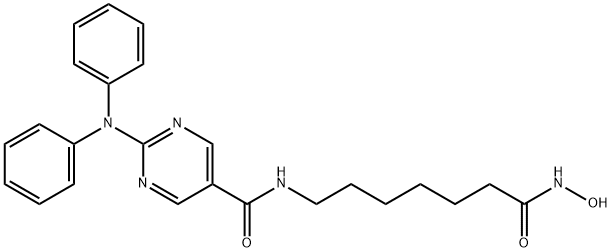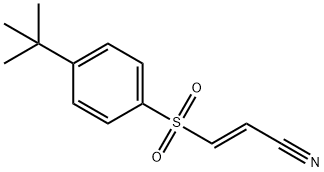Pracinostat
- CAS NO.:929016-96-6
- Empirical Formula: C20H30N4O2
- Molecular Weight: 358.48
- MDL number: MFCD17215206
- SAFETY DATA SHEET (SDS)
- Update Date: 2024-11-19 23:02:33
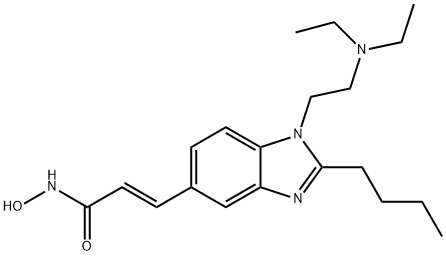
What is Pracinostat?
The Uses of Pracinostat
Pracinostat is a potent and orally active histone deacetylase (HDAC) inhibitor with high tumor exposure and efficacy in mouse models of colorectal cancer. The selectivity of Pracinostat for tumor tissues makes it a promising therapeutic candidate for use in patients with advanced solid malignancies.
The Uses of Pracinostat
Pracinostat is a potent and orally active histone deacetylase (HDAC) inhibitor with high tumor exposure and efficacy in mouse models of colorectal cancer. The selectivity of Pracinostat for tumor tissues makes it a promising therapeutic candidate for use in patients with advanced solid malignancies. Potent Histone deacetylase inhibitor.
What are the applications of Application
SB939 is a non-selective inhibitor of HDAC
Definition
ChEBI: Pracinostat is a hydroxamic acid that is N-hydroxyacrylamide which is substituted at position 3 by a 2-butyl-1-[2-(diethylamino)ethyl]-1H-benzimidazol-5-yl group (the E isomer). An orally available pan-histone deacetylase inhibitor with demonstrated activity in the treatment of advanced solid tumours. It has a role as an EC 3.5.1.98 (histone deacetylase) inhibitor, an antineoplastic agent, an apoptosis inducer and an antimalarial. It is an olefinic compound, a hydroxamic acid, a benzimidazole and a tertiary amino compound.
Biological Activity
pracinostat, also known as sb939, is a potent and orally available inhibitor of histone deacetylase (hdac) with a relatively stronger selectivity (more than 1000-fold) for class i, class ii and class iv hdacs rather than class iii hdacs. pracinostat potently suppresses proliferation in a wide range of cancer cell lines, including colon cancer, ovarian cancer, prostate carcinomas, acute myeloid leukaemia (aml) and b cell lymphoma. recent study results have shown that sb939 induces the accumulation of acetylated histone h3 (ach3) and acetylated α-tubulin and increases the expression of the cyclin dependent kinase inhibitor p21 in cancer cells.razak ar, hotte sj, siu ll, chen ex, hirte hw, powers j, walsh w, stayner la, laughlin a, novotny-diermayr v, zhu j, eisenhauer ea. phase i clinical, pharmacokinetic and pharmacodynamic study of sb939, an oral histone deacetylase (hdac) inhibitor, in patients with advanced solid tumours. br j cancer. 2011;104(5):756-762.
Properties of Pracinostat
| Density | 1.11 |
| storage temp. | Store at -20°C |
| solubility | insoluble in H2O; ≥11.4 mg/mL in DMSO; ≥24.8 mg/mL in EtOH with ultrasonic |
| form | solid |
| pka | 8.67±0.23(Predicted) |
| color | White to light brown |
Safety information for Pracinostat
Computed Descriptors for Pracinostat
New Products
(S)-3-Aminobutanenitrile hydrochloride 4-Methylphenylacetic acid N-Boc-D-alaninol N-BOC-D/L-ALANINOL Tert-butyl bis(2-chloroethyl)carbamate 3-Morpholino-1-(4-nitrophenyl)-5,6-dihydropyridin- 2(1H)-one Furan-2,5-Dicarboxylic Acid Tropic acid 1-Bromo-3,5-Di-Tert-Butylbenzene S-2-CHLORO PROPIONIC ACID ETHYL ISOCYANOACETATE 2-Bromo-1,3-Bis(Dimethylamino)Trimethinium Hexafluorophosphate 4-IODO BENZOIC ACID 3-NITRO-2-METHYL ANILINE 1-(2,4-DICHLOROPHENYL) ETHANAMINE (2-Hydroxyphenyl)acetonitrile 4-Bromopyrazole 2-(Cyanocyclohexyl)acetic acid 4-methoxy-3,5-dinitropyridine 1-(4-(aminomethyl)benzyl)urea hydrochloride 2-aminopropyl benzoate hydrochloride diethyl 2-(2-((tertbutoxycarbonyl)amino) ethyl)malonate tert-butyl 4- (ureidomethyl)benzylcarbamate Ethyl-2-chloro((4-methoxyphenyl)hydrazono)acetateRelated products of tetrahydrofuran
You may like
-
 Pracinostat 98% (HPLC) CAS 929016-96-6View Details
Pracinostat 98% (HPLC) CAS 929016-96-6View Details
929016-96-6 -
 2033-24-1 98%View Details
2033-24-1 98%View Details
2033-24-1 -
 1975-50-4 98%View Details
1975-50-4 98%View Details
1975-50-4 -
 2-HYDROXY BENZYL ALCOHOL 98%View Details
2-HYDROXY BENZYL ALCOHOL 98%View Details
90-01-7 -
 2-Chloro-1,3-Bis(Dimethylamino)Trimethinium Hexafluorophosphate 221615-75-4 98%View Details
2-Chloro-1,3-Bis(Dimethylamino)Trimethinium Hexafluorophosphate 221615-75-4 98%View Details
221615-75-4 -
 61397-56-6 CIS BROMO BENZOATE 98%View Details
61397-56-6 CIS BROMO BENZOATE 98%View Details
61397-56-6 -
 14714-50-2 (2-Hydroxyphenyl)acetonitrile 98+View Details
14714-50-2 (2-Hydroxyphenyl)acetonitrile 98+View Details
14714-50-2 -
 118753-70-1 98+View Details
118753-70-1 98+View Details
118753-70-1

